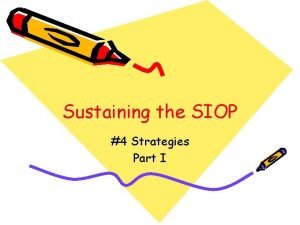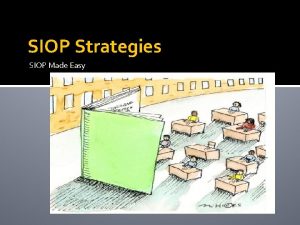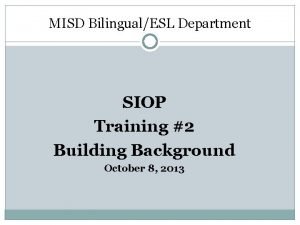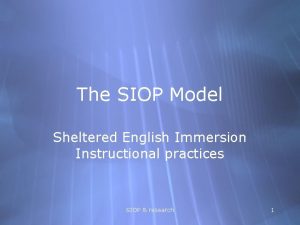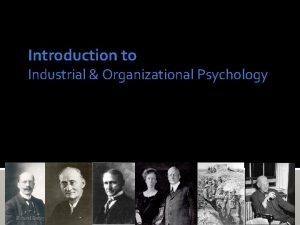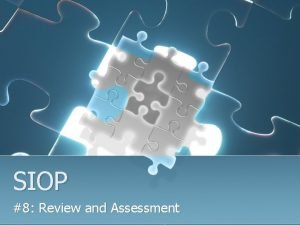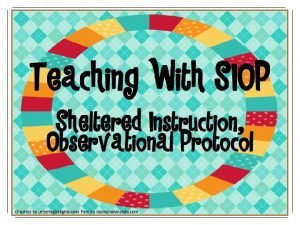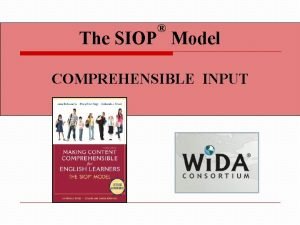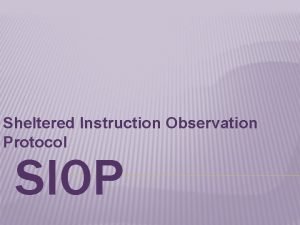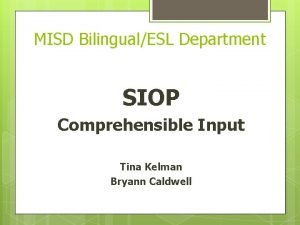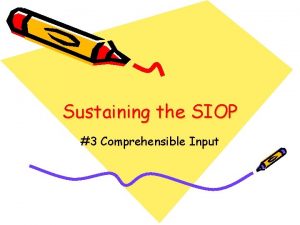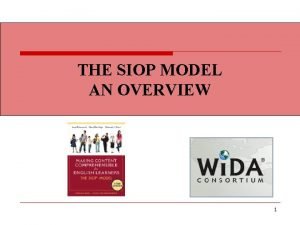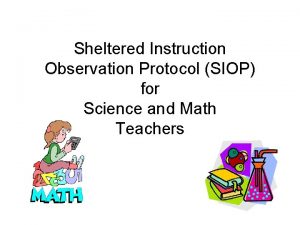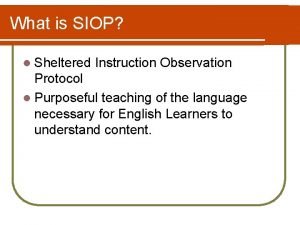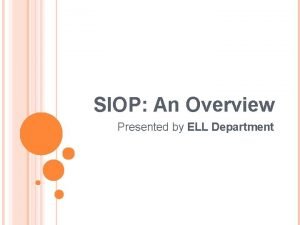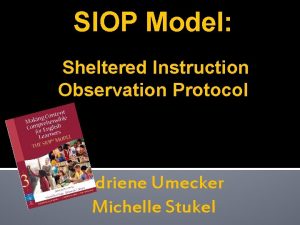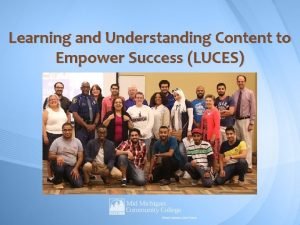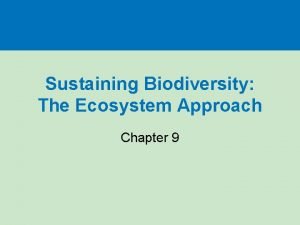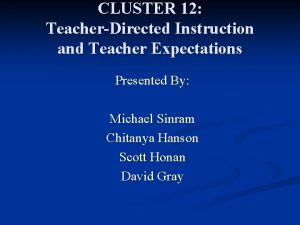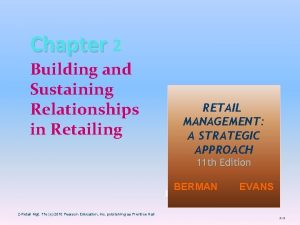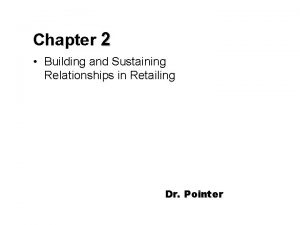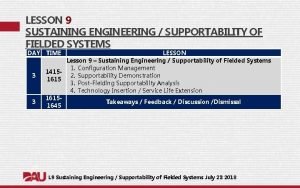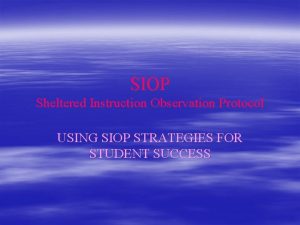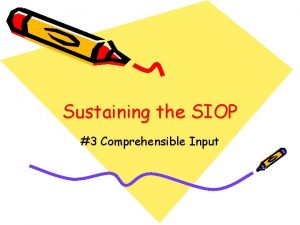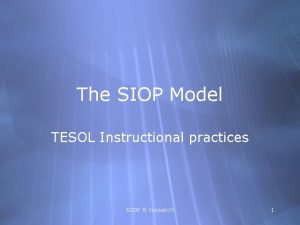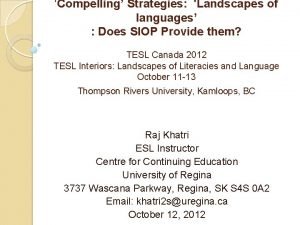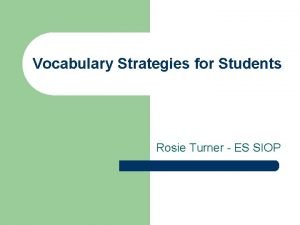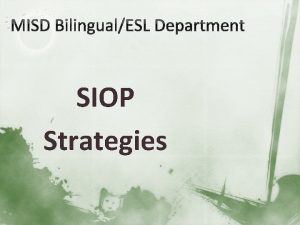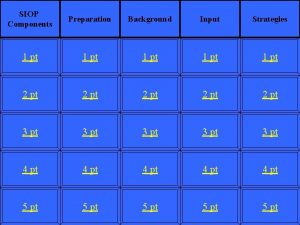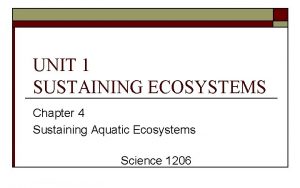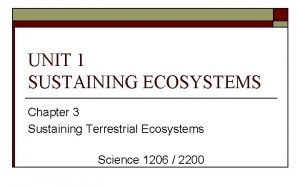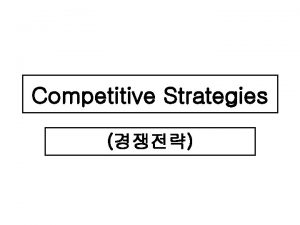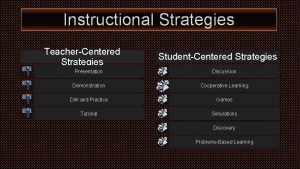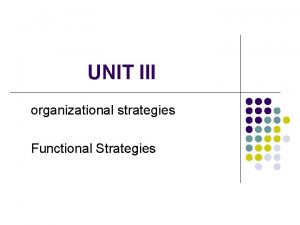Sustaining the SIOP 4 Strategies Part I Sustaining



































- Slides: 35

Sustaining the SIOP #4 Strategies Part I

Sustaining the SIOP Content Objectives • Educators will be able to discuss different learning strategies students can use • Educators will be able to demonstrate knowledge of strategies Language Objectives • Educators will be able to read, write, and discuss word walls using the Gist strategy • Educators will be able to orally describe word wall examples with a partner

SIOP’s 8 Components 1) Lesson Preparation 2) Building Background 3) Comprehensible Input 4) Strategies 5) Interaction 6) Practice & Application 7) Lesson Delivery 8) Review & Assessment

Sustaining the SIOP Macarena

Lesson Preparation

Building Background

Comprehensible Input

Strategies

Interaction

Practice & Application

Lesson Delivery

Review & Assessment

SIOP’s 8 Components 1) Lesson Preparation 2) Building Background 3) Comprehensible Input 4) Strategies 5) Interaction 6) Practice & Application 7) Lesson Delivery 8) Review & Assessment

Sustaining the SIOP #4 Strategies Part I

Strategies: 3 Features 1) Ample opportunities for students to use learning strategies 2) Scaffolding Techniques used consistently 3) Higher-Order thinking Questions and tasks

Ms. Russell Video • What strategies did the teacher use in the video? • How will these strategies help ELL students (English Language Learner)? Non-ELL’s? • How could you apply some of her strategies to your grade-level?

Continuum of Strategies See handout 6. 5 • Teacher-Centered – Demonstration • Teacher-Assisted – Drill and practice • Peer-Assisted – Role playing • Student Centered – Organization Strategies

Word Walls • • • Alphabetical Photo Themed Portable Student Generated Teacher Generated

Word Walls in Action Math Word Wall – http: //www. youtube. com/watch? v=TNPp R-_Alak Secondary Word Wall uses http: //www. youtube. com/watch? v=i. W Gk 8 LEr. Q 6 Y

Word Walls

Word Walls

Creating/Sharing • On one side of a • Share your ideas note card, write and let your down one word wall partner write down example that could the idea on the work for your back of their own students, be as note card and specific as possible. tailor it to their own situation. • Repeat the process.

Comprehension Strategies

GIST Generating Interactions between Schemata and Texts (Cunningham, 1982; as scited in Muth & Alvermann, 1999) 1)Teacher & students read a short text together. 2) Students underline ten words or concepts that are deemed the most important. 3) Teacher lists the words on the board. 4) Without the text, write a summary sentence or two using as many of the listed words and concepts as possible.

Let’s try to get the GIST! • Read Word Walls: A Support for Literacy in Secondary School Classrooms in groups of 2 or 3. • Underline 10 words or phrases. • List the words or phrases on the board. • Write and tell a summary of the article using as many words or phrases as possible.

THIEVES Bookmarks – Title- ask students to make a prediction – Headings- how text is organized, what will be covered in this lesson/chapter/unit – Introduction- use to predict the main idea

THIEVES Bookmarks con’t – Everything (I Know about it)- build on background knowledge of topic – Visuals- Use pictures/graphs/maps etc. – End of Chapter- read summary/questions – So What? - Why did the author write this?

Scan and Run • 4 “SCAN” cues to preview chapter – – Survey headings and turn them into questions Capture the captions and visuals Attack boldface/vocabulary words Note end of the chapter questions • “RUN” while reading – Read and adjust speed – Use skills to identify unfamiliar words – Notice/mark areas that you don’t understand or are unfamiliar

Graphic Organizers 11/28/2020

Graphic Organizers SANDWICH Other Organizers • http: //www. edupla ce. com/graphicorg anizer • These graphic organizers are available in Spanish as well!

Graphic Organizers BEW Blueprints • The blueprints are designed to help students organize their ideas for each writing genre. • Sample Blueprints – Research Project – Fable Jennifer A. Fontenot & Karen J. Carney

Fable Blueprint A story that teaches a moral lesson via a brief plot using animal characters that have human characteristics. The purpose of this genre is to teach a moral lesson. • 1) Story Beginning – Identify setting – Define characters • 2) Plot – – Single event plot Climax with trickery Talking animals Human faults • 3) Story Ending – Moral of the story

Fable Blueprint Orally create a fable using the blueprint 1) Story Beginning – Identify setting – Define characters 2) Plot – – Single event plot Climax with trickery Talking animals Human faults 3) Story Ending – Moral of the story

Tickets Out Did we meet our objectives? Something I didn’t understand…. One new thing that I learned or relearned was… Something I would like to learn more about next time….

See you next time Thursday, April 26, 2012
 Siop strategies
Siop strategies Siop strategies
Siop strategies Who is this
Who is this Siop model
Siop model Masters in i-o psychology salary
Masters in i-o psychology salary Siop lesson delivery
Siop lesson delivery Review and assessment siop
Review and assessment siop Siop.gov.br
Siop.gov.br Anticipation guide definition
Anticipation guide definition Siop comprehensible input
Siop comprehensible input Academy of fine arts vienna
Academy of fine arts vienna Siop sheltered instruction
Siop sheltered instruction Siop comprehensible input
Siop comprehensible input Comprehensible input examples
Comprehensible input examples Language spanish
Language spanish Shel silverstein money poem smart
Shel silverstein money poem smart Siop observation protocol
Siop observation protocol What is siop
What is siop What does siop stand for
What does siop stand for Siop model
Siop model Siop model components
Siop model components What is the ecosystem approach to sustaining biodiversity
What is the ecosystem approach to sustaining biodiversity Sustaining expectation effect
Sustaining expectation effect Environmental science sustaining your world
Environmental science sustaining your world Fugle innovation process model
Fugle innovation process model Sustaining relationships
Sustaining relationships Sustaining change
Sustaining change Value oriented retail strategy
Value oriented retail strategy The life-sustaining substances in food are called
The life-sustaining substances in food are called Building commitment
Building commitment The energy needed to maintain life-sustaining activities
The energy needed to maintain life-sustaining activities Building and sustaining relationships in retailing pdf
Building and sustaining relationships in retailing pdf Ways to protect the ecosystem
Ways to protect the ecosystem Apes chapter 9 sustaining biodiversity
Apes chapter 9 sustaining biodiversity Sustaining engineering definition
Sustaining engineering definition Sustaining excellence
Sustaining excellence
